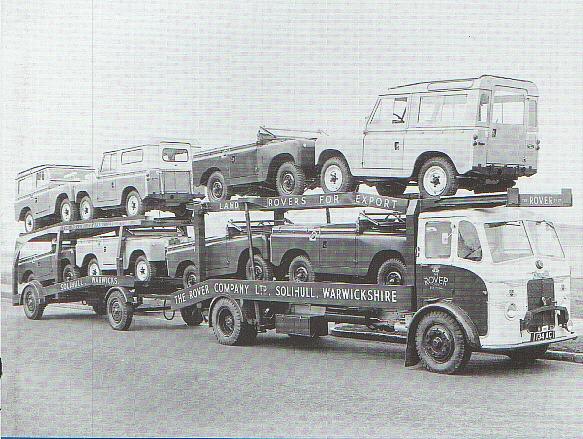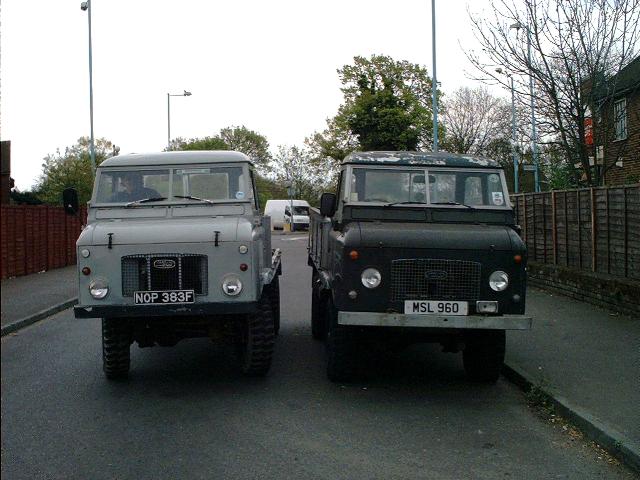The Land-Rover Series Two was released to the world’s press on 16th April 1958. This Land-Rover differed from its predecessor noticeably as the Rover stylists had added a curved styling feature to the body side breaking up the previous slab sided look. Modesty cill panels had also been added to hide the chassis in all creating a more styled and finished look to the vehicle.
A number of mechanical improvements had taken place under the bodywork, mainly wider axles, (these gave a much improved turning circle), and the new 2286cc four cylinder petrol engine, (although the 88”short wheelbase had to wait until September to gain the new engine, keeping the previous models 1997cc engine).
The Land-Rover Series Two was released to the world’s press on 16th April 1958. This Land-Rover differed from its predecessor noticeably as the Rover stylists had added a curved styling feature to the body side breaking up the previous slab sided look. Modesty cill panels had also been added to hide the chassis in all creating a more styled and finished look to the vehicle.
A number of mechanical improvements had taken place under the bodywork, mainly wider axles, (these gave a much improved turning circle), and the new 2286cc four cylinder petrol engine, (although the 88”short wheelbase had to wait until September to gain the new engine, keeping the previous models 1997cc engine).

Although the Series Two gave the appearance of being radically new, the Rover Company had continued their policy of evolution not revolution, this policy was easy to spot when looking under the skin of the new models and finding many of the parts from their predecessors which now became known as Series Ones.
Look at the electrical system for instance, fuse box and junction box were Series One parts, the mounting plate for the fuse box and regulator had holes for the electric fuel pump fitted to the 1997cc engine. Indicators were an optional extra and the wiring was a separate loom until the event of the last of the Two’s leading to the introduction of the Series IIa’s in 1961.
The original Series Two front wings only had one hole for sidelamps.
The Diesel engine remained as fitted to the Series One, the 2052cc Four-cylinder Rover unit.
The Series Two gave way to the Series IIa in September 1961 when the main change was to the Diesel engine which was redesigned along the lines of the current petrol engine and moved up to the petrol engine’s capacity of 2286cc. The petrol engine also gained minor changes such as the water pump and the rest of the cooling system.
The are many more differences between Series Two’s and the other Land-Rovers, the moral of the story being if you find a Series Two in original condition restore it sympathetically as unmodified Series Twos are becoming extremely rare.
Information supplied with permission and copyright to Dixon Kenner
The Series IIa was available in 88” (Regular) or 109” (Long) wheelbase.
During the model’s life small changes occurred starting with the instrument panel changing from body colour to black, the loss of chrome headlamp bezels, and the flat apron being replaced by the curved variety. The most visible change occurred in spring 1968 when export models emerged with their headlamps repositioned to the wings. Home customers had to wait until May 1969 when models for the home market where sold with new look to comply with new lighting regulations. The Series IIa continued until 1971 when it was replaced by the Series Three.
Production of the Series Two Station Wagons commenced with only the 88” on the release date in April1958. Customers for the long wheel base had to make do with the series One which remained on sale until the release of the Series Two 109” Station Wagon in September 1958.
The Station Wagons were to become the classic Land-Rover seen in many films and television programs and their ancestry can still be seen in today’s TD5 Defender Estates.
Initially the Series II and IIa models were fitted either Rover’s four cylinder petrol or diesel engines, but in May 1967, the 6 cylinder was introduced. Production continued throughout the 1960’s with various small modifications until the final Series IIa 109” Station wagons manufactured from February 1971 until the in the introduction of the Series Three in September 1971. These last Series IIa Station Wagons (chassis suffix H) were fitted with all syncromesh gearboxes as later fitted to all Series Three’s, and Salisbury rear axles as fitted to Series Three 109” models.
How can you tell the difference between Series Twos and early IIa’s?
The easiest way is the chassis number as the Series Two had a nine digit number that included the year of manufacture as the forth digit. Series Two chassis numbers started with a 1. Series IIa chassis numbers start with a 2, and comprise of 8 digits.
141 0 02546 is a Series Two, 88” petrol, 1960 build, car 2546.
is a Series IIa, 88” petrol, 2546th built since start of IIa production.
For a month-by-month (ish) breakdown of changes between 1958 to 1971 please see our Vehicle Timeline page.
The Forward Control model was Land Rover’s answer to calls from customers for more payload . The prototype of this vehicle first ran in 1960 and was available as a Series IIa from September 1960. The Series IIa Forward Control had a 109” wheelbase, using 75% of the standard 109” chassis components. This vehicle was only available with the Rover’s four-cylinder petrol engine of 2286cc. The vehicle was under powered and unstable due to the combination of vehicle height and standard width axles.
To improve the vehicle the Rover engineers completely re-designed the vehicle, including options of Rover’s six-cylinder petrol engine of 2625cc, the length of which necessitated moving the front axle forward 1” increasing the wheelbase to 110”. This vehicle the Series IIb was introduced in September 1966, the other modifications including wider and stronger axles and stronger transmission.

The easiest way is Series IIa (High headlamps), Series IIb (Low headlamps). In the picture above the IIb 110 is on the left.
If you wish to find out more just ask. For advice contact the Vehicle Registrations Officer or why not post a question at our active Web Forum ?
with thanks to David Dutton
We would like to hear from you. Please send us a message by filling out the form below and we will get back to you shortly.
If you wish to make an enquiry about your vehicle being MOT exempt either fill in the form below or email your enquiry to Alex Bywaters – [email protected].
Classified Vehicle Sales
Soon you will be able to advertise your Series vehicle – not parts – for free on our very own classified pages. Currently this feature is being fine tuned, release planned for the end of September 2024.
Send your photos to our Social Media officer – Tom Wright, for use on the clubs social platforms. Thank you.
If you find a YouTube workshop video that you think others would enjoy watching then please do let us know by filling in the details below. We can then add it to this webpage.
Membership Overdue
It appears that your membership is overdue (expiry ). If you wish to continue to access the ‘Members Section’ pages then please renew your membership by visiting https://series2club.co.uk/how-to-join/
Please enter as much information as you can. You will be able to upload documents as the last step of this form.